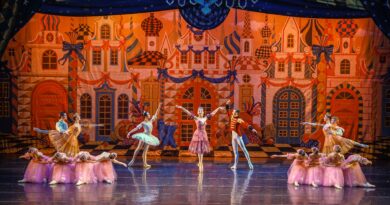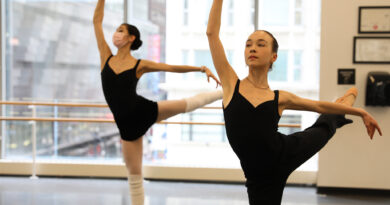Body Language
Using the language of dance, Chicago’s Red Clay Dance Company explores prevalent issues emanating from the world around us via the vehicle by which we experience the world, the body.
Dance as an art form is an intriguing and unique animal, when you think about it. It has a language capable of expressing what the voice or written word cannot so aptly convey. Vershawn Sanders-Ward, artistic director for Red Clay Dance Company understands this keenly as she is a master of the language the body alone speaks. As she explained to me this winter, it’s a “language that is visceral and connects to the heartbeat of our world.” That knowledge is the basis for Red Clay Dance Company’s spring performance entitled “Visions & Voices,” a program that will include three new works by emerging choreographers whose dance is impacted by and expressive of the world around us, expressive of the language our bodies employ to connect to our environment and what it means for us as people. Sanders-Ward explained, “Our bodies move through the world, and it is in our bodies that we experience and hold all lived experiences. Our bodies are designed to be connected to everything in our environment, and so the joys, sorrows, pain, love, hate, all the things that are floating in, around and through us can be best expressed through the body because that is how we experience them.”
Esoteric as it may sound, this concept, as Sanders-Ward explained, is quite natural to our beings. If movement, and therefore dance, is a language of expression, then what we express is quite naturally based on what we experience, and that expression is as individual and distinct as we are one from another. “We are living, moving beings that experience life inside these bodies you will see on stage,” she told me. “So living and breathing, existing is an expression of the world around us. The dancers are a lived expression of the world, each body has its own experiences they bring to each work and fills out the artist vision set by each choreographer. These bodies bring their own thoughts, ideas, life experience to the theme of each work.”
So what audiences will see onstage this spring is likely to be a program of exceptionally personal and intimate dancework. On that program is the dark and haunting work FAKE NEWS!!, a work that explores the planes of immigration, capitalism, democracy and power—all themes ever present in today’s media-obsessed and political landscapes. Sanders-Ward describes the choreography as “grounded, crawling, sliding with moments of short jumping bursts of energy.” The music is comprised of a beautiful mix of African drumming and techno/house.
Sanders-Ward’s work Harvester explores the choreographer’s own lived experience of moving throughout the world identifying as a “womyn,” as she expresses it, struggling on her journey to shape her own identity outside of the patriarchy that is woven through most every part of our society. She explains the experience is not meant to erase the idea of manhood, but to chart a path independent of that structure, one that is liberating for Sanders-Ward, herself.
She also explains that the work endeavors to explore the idea that “women do the work of processing so many things for other people (children, parents, friends, lovers, significant others) that “if we’re not careful, only those things can begin to define our worth. They can begin to define our value. I’ve been re-reading Women, Race and Class by Angela Davis,” she explains. “And looking at how the value of all women were defined during slavery times, war times, industrial times and processing how that lives inside our society today.”
The work is abundant with the unique movement vocabulary Sanders-Ward has been developing over the past 11 years. It is unapologetically rooted in African Diasporic culture and flows effortlessly from house to contemporary to capoeira to movement from Mali/Senegal. The choreography is sharp with moments of fluidity celebrating the supple spine and liberation pelvis found in many African Diaspora dance forms.
Among the highlights in “Visions & Voices” is INCARNATION 1 by New York choreographer Du’Bois A’Keen. Receiving its world premiere in this program, INCARNATION 1 examines the body as “archive, altar and access point.” It is set in the “present/future” but experienced in retrospect caught in a kind of time lapse. It asks the question, “How do we prepare ourselves to be good ancestors? What are we downloading to pass on?”
Set to a baleful yet beautiful soundscore comprised of music of Kingsley Ibeneche, Moses Sumney, Shake and Jessie Reyez. The work is reflective, narrative, resonant with what A’Keen calls, “…things we have seen before and experiences we have lived.” These images, A’Keen tells me help to anchor us in the world of this work. “It feels episodic in nature,” he explains. Through a montage of motifs and manipulations, we are pulled in through the duration of the choreography as movements return and riffs repeat. With costumes concepted by A’Keen and styled by K. Fleye, INCARNATION 1 is a poignant, magical journey audiences won’t soon forget.
Philadelphia choreographer Lela Aisha Jones’s world premiere, we: all ~ gon’ die into revivals is an artistic and soulful labor that expresses dreams for blackness and reciprocity within the natural environment. Its presence on “Visions and Voices” points audiences to our sense of self in the world around us. She explained, “the work is about centering in the wisdom that you value, not what has been given to you by someone who does not understand your way of being in the world. That may be right for them but not for you, not for your family or your well-being.” The work asks the question, “How do we fully embrace, come what may, what we know we need to be?”
The movement, she says, is something akin to ceremony, “some may say ritual,” as Jones told me. “I try to create a landscape, an altar that is composed of props and beings with bodies. I want it to feel like something you know and then all of a sudden something someone dreamed or a memory that never happened but could. The body is aching and healing at the same time—the way a juke joint feels—then dancing through a valley or on top of a mountain or underneath a waterfall, dancing so close that you almost become the other being…Energy as a technique is how I would describe it. It is not just flowing through Black and African Diasporic movement and modern and freestyle and witnessing…When experiencing the work, I guess I want all types of memories and possibility to be conjured.” Rather than get muddled in choreographic category, Jones insists she’s more interested in understanding just where the work takes all who experience it.
At its core, the program is indicative of the unique balance for which Sanders-Ward’s Red Clay Dance Company is so well known. The equanimity with which the company balances both athleticism and artistry is signature for Red Clay. It is a concept that is quite remarkable, but for Sanders-Ward it is simply a hallmark of her training and the fabric of her own understanding of dance as a language.
She explained, “Honestly, (that balance) has been my training, and I believe that is what dance is. When I look at the work of some of my mentors—Jawole Zollar, Ronald K. Brown—I see such a balance, and I don’t know how to work in any other way. Dancers are athletes and creators; both must exist to fulfill our purpose.”
It’s that unique balance that Sanders-Ward sites as the key element of her own dance language and so elemental to her own experience of dance and an admitted foundational aspect of her company. “I love the feeling, and the gift of conversing with another human through the physical form. That is what drew me to dance. So there are multiple ‘techniques’ that exist within my body, and I look for artists that view dance in a similar way when bringing new company members inside the process.”
Red Clay Dance Company developed from the experience of Vershawn Sanders-Ward’s first trip to Africa—Toubab Dialaw, Senegal, to be exact—in 2007. The experience marked for her the first time she had given great thought to how she wanted to use her own artistic gifts. It was in Senegal at L’Ecole De Sables that she witnessed the interconnectedness of dance and daily life firsthand. It was that interconnectedness that Sanders-Ward wanted to be the foundational value of her own dance company.
Red Clay Dance Company was born. The name stems from the red earth she played in during summers with her grandparents in their home of Mobile, Alabama. “The red earth was a playground for me as a kid, and I would use it to make all sorts of crazy things,” she told me. “It was like clay, something I could take with my hands and mold into something spectacular—and this is how I view my choreographic work, a shaping and molding of our humanness expressed through dance, a visceral experience with our embodied memories.”
Memories will certainly be made in abundance when Red Clay Dance Company takes the stage with “Visions and Voices” April 3 and 4 at the Harold Washington Cultural Center, 4701 S. King Drive, Chicago, IL 60653.




